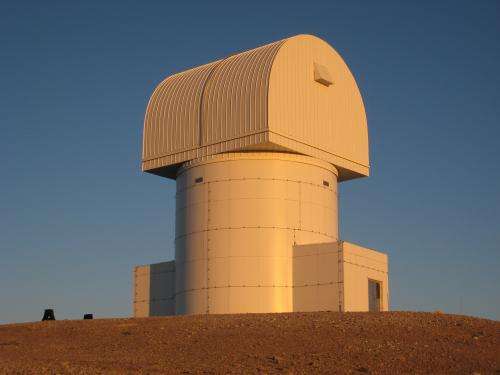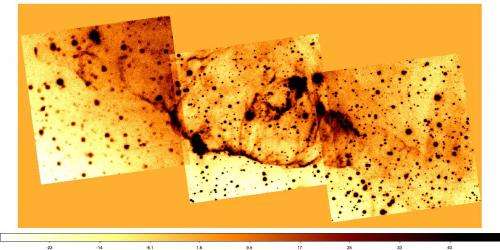New Greek observatory sheds light on old star

(Phys.org)—Continuing a tradition stretching back more than 25 centuries, astronomers have used the new 2.3-m 'Aristarchos' telescope, sited at Helmos Observatory (2340m high) in the Pelοponnese Mountains in Greece, to determine the distance to and history of an enigmatic stellar system, discovering it to likely be a binary star cocooned within an exotic nebula. The researchers, Panos Boumis of the National Observatory of Athens and John Meaburn of the University of Manchester, publish the first scientific result from the telescope in the journal Monthly Notices of the Royal Astronomical Society.
Stars of a similar mass to the Sun end their lives by ejecting much of their outer atmosphere into space, leaving behind a remnant core that eventually becomes a so called white dwarf. The shells of ejected material sometimes have the superficial appearance of planets so were named planetary nebulae. Astronomers can study the motion and appearance of the material in planetary nebulae to deduce how the remnant stars have changed over time.
In the 1950s the planetary nebula KjPn8 was discovered on Palomar Observatory Sky Survey plates. Follow up work in the 1990s by Mexican astronomers at the San Pedro Martir Observatory led to the discovery of giant lobes around the system, one quarter of a degree across, while in 2000 the central star was finally revealed by the Hubble Space Telescope.
Dr Boumis and Prof. Meaburn set out to study this system, installing a narrowband imaging camera on the Aristarchos telescope, the largest aperture instrument in south-eastern Europe, to measure the expansion more accurately.

By measuring the velocity and increasing size of the expanding material, the two scientists were able to deduce the distance to the system and date the history of the three ejected lobes. They found that KjPn8 is around 6000 light years away and that the material was thrown out in three phases 3200, 7200 and 50000 years ago.
The inner lobe of material is expanding at 334 km per second, suggesting it originates in an Intermediate Luminosity Optical Transient (ILOT) event. ILOTs are caused by the transfer of material from a massive star to its less massive companion, in turn creating jets that flow in different directions. Boumis and Meaburn believe that the core of KjPn8 is therefore a binary system, where every so often ILOT events lead to the ejection of material at high speed.
Dr Boumis is delighted to see the first results from the new telescope giving clues to the history of such an intriguing system. He comments: "Greece is one of the global birthplaces of astronomy, so it is fitting that research into the wider universe continues in the 21st century. With the new telescope we expect to contribute to that global effort for many years to come."
Journal information: Monthly Notices of the Royal Astronomical Society
Provided by Royal Astronomical Society




















